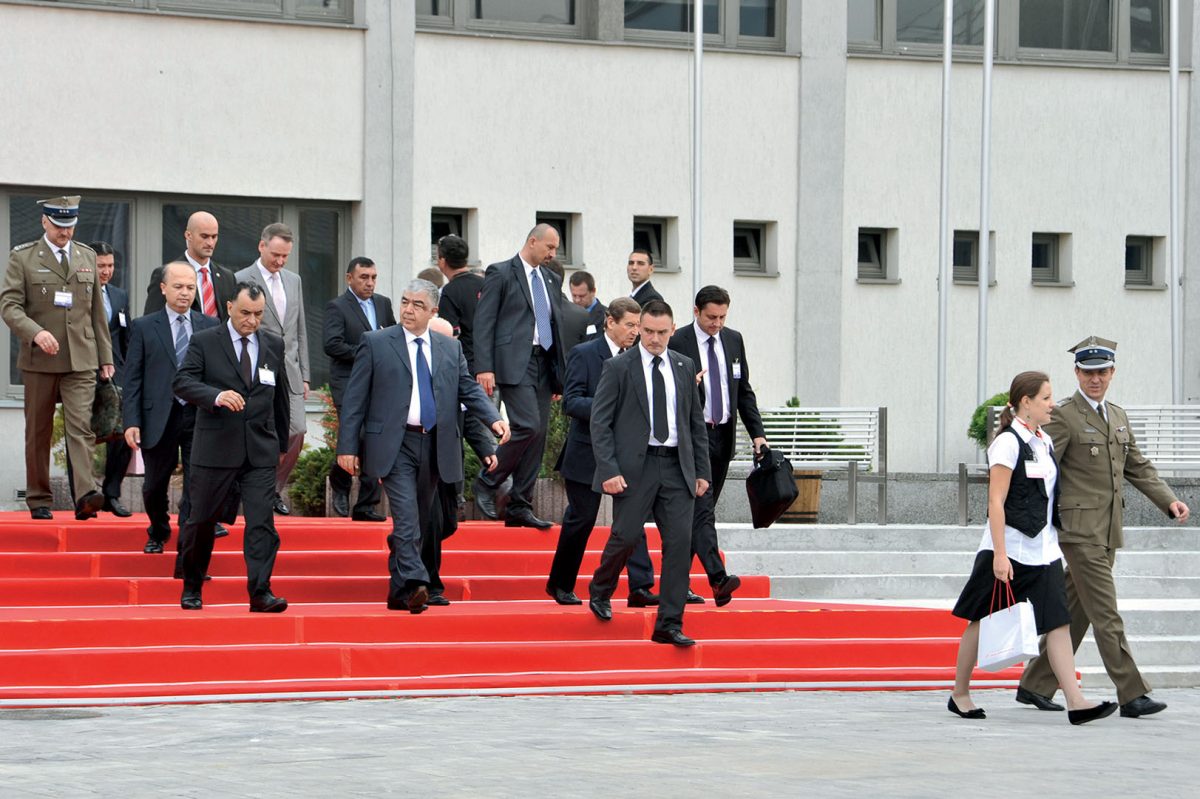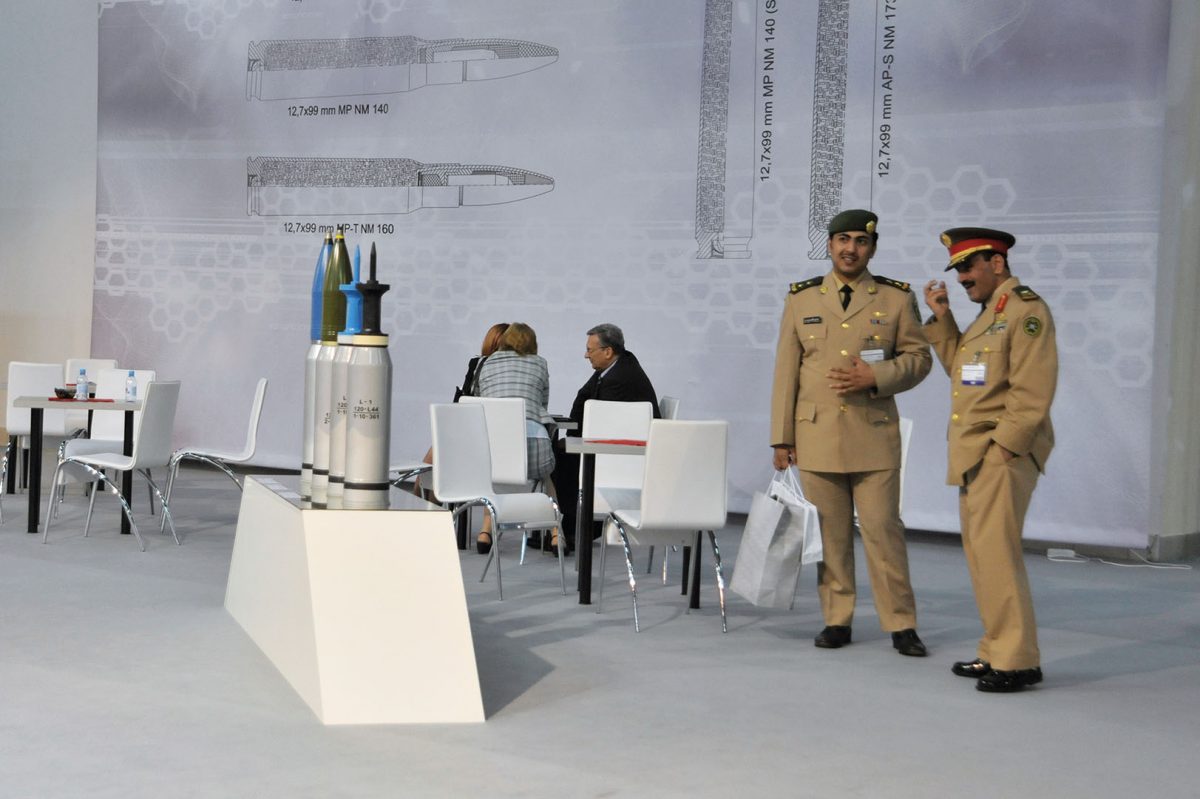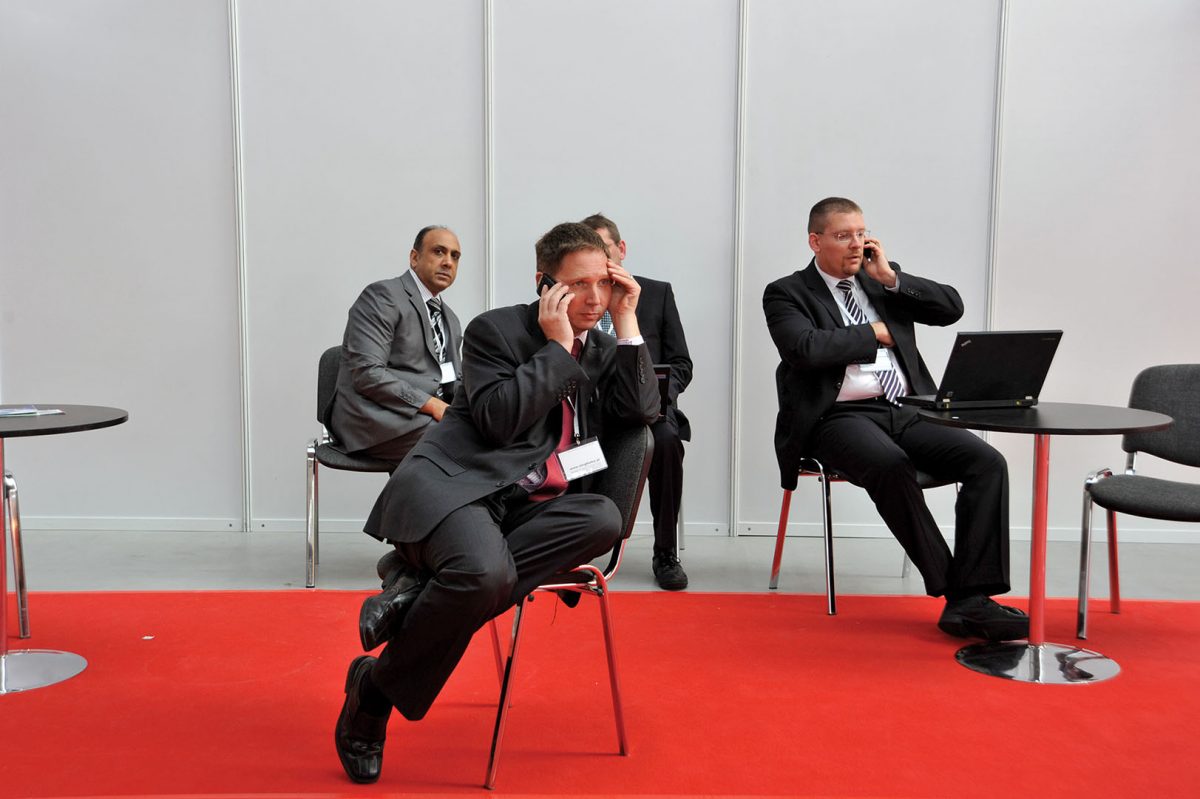Série de 8 photographies / 23cm x 34.5cm Diasec / 2012
Cette série de photos a été réalisée dans le cadre d’un projet pour lequel je me suis rendue à la « International Defence Industry Exhibition » en Pologne, en 2012. Quelque 400 exposants provenant de 29 pays se sont déplacés à l’occasion de ce salon, l’un des trois salons de l’armement les plus importants d’Europe. Ils y proposent leurs « biens et services ». Le monde politique et le monde des affaires s’y rencontrent, s’y montrent sans se préoccuper d’un quelconque regard critique, et négocient des contrats, des relations et des marchés. Le salon se déroule dans une ambiance typique pour ces évènements, festive, accompagnée d’offres culinaires et musicales. Les hôtesses, quant à elles, se chargent elles aussi de veiller à une atmosphère accueillante.
C’est ici que l’on peut observer la construction et distorsion de réalités, une forme frappante de banalisation de la guerre, de la politique armée et des forces militaires. On y assiste à une représentation de la guerre dépourvue de sa réalité, traduite en spectacle ou en événement technologique, ce qui m’amène à mettre en lumière la question de l’in/visibilisation. Pour cela, je m’appuie également sur le pouvoir de l’image tel que l’a notamment analysé et dénoncé Judith Butler :
“Efforts to control the visual and narrative dimensions of war delimit public discourse by establishing and disposing the sensuous parameters of reality itself – including what can be seen and what can be heard. As a result, it makes sense to ask, does regulating the limits of what is visible or audible serve as a precondition of war waging, one facilitated by cameras and other technologies of communication?“
Judith Butler, dans : « Frames of War: When Is Life Grievable? » Brooklyn, NY: Verso, 2009
Serie 8 Fotografien / 23cm x 34.5cm Diasec / 2012
Diese Fotoserie ist ein Teil einer Recherche, im Rahmen welcher ich 2012 nach Polen an die „International Defence Industry Exhibition“ fuhr. An dieser Messe stellen ungefähr 400 Firmen aus 29 Ländern ihre „Waren“ und „Dienstleistungen“ aus. Politik und Wirtschaft stellen sich Hand in Hand vereint ins Rampenlicht, und ohne jegliche Sorge um mögliche kritische Blicke werden eine Woche lang Verträge, Verbindungen und Geschäfte ausgehandelt. All dies geschieht in einem messeüblichen, festlichen Rahmen, in dem rund um die Uhr kulinarische und musikalische Unterhaltung geboten werden. Die meist weiblichen Messehostessen sorgen ebenfalls für eine „einladende“ Stimmung für die Geschäftsleute und Politiker.
Konstruktion und Verzerrung von Realitäten wurde während dieser Messe direkt erkennbar. Diese Form der Banalisierung von Armeegewalt, in der die Realität des Krieges komplett ausgeblendet und stattdessen als Spektakel und Technologie-Event vorgeführt wird, zeigt die sehr aktuellen Fragen der (un-)Sichtbarmachung auf.
Um diese Fragen weiter zu denken, greife ich hier unter anderem auch auf den Textauszug von Judith Butler zurück, der als Texttafel in die Fotoserie integriert wird :
„Efforts to control the visual and narrative dimensions of war delimit public discourse by establishing and disposing the sensuous parameters of reality itself – including what can be seen and what can be heard. As a result, it makes sense to ask, does regulating the limits of what is visible or audible serve as a precondition of war waging, one facilitated by cameras and other technologies of communication?“
Judith Butler, in: “Frames of War: When Is Life Grievable?“ Brooklyn, NY: Verso, 2009
Series of 8 photos / 23cm x 34.5cm Diasec / 2012
This series of photographs is part of a research project that took me 2012 to an international Defence Exhibition in Poland. There are around 400 companies from 29 countries at this trade fair, presenting their “goods” and “services”. Politics and business go hand and hand into the spotlight. For a week, contracts, agreements and deals are negotiated – and no-one worries about possibly being observed by a critical eye. All of this takes place at a standard trade fair: there is a festive atmosphere, with culinary and musical entertainment provided round the clock. Predominantly female trade fair hostesses also help create a “inviting” environment for businesspeople and politicians.
Reality-distorting constructions seemed to hit me right between the eyes over the course of these few days. The fair is a way of utterly trivialising armed politics and military force. The reality of war is completely masked and replaced with a show of technology and entertainment, and, in my opinion, this perfectly illustrates the very pertinent and complex issues surrounding how realities are made (in)visible. To consider this question further, I refer to extracts of texts, including this one by Judith Butler:
„Efforts to control the visual and narrative dimensions of war delimit public discourse by establishing and disposing the sensuous parameters of reality itself – including what can be seen and what can be heard. As a result, it makes sense to ask, does regulating the limits of what is visible or audible serve as a precondition of war waging, one facilitated by cameras and other technologies of communication?“
Judith Butler, in: “Frames of War: When Is Life Grievable?“ Brooklyn, NY: Verso, 2009




